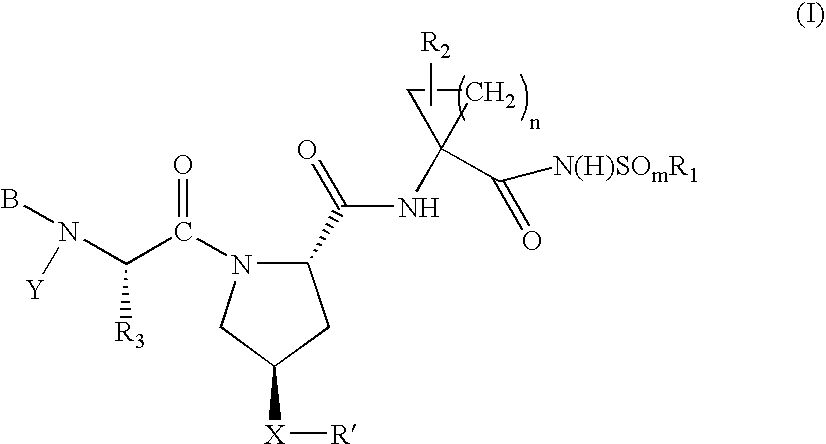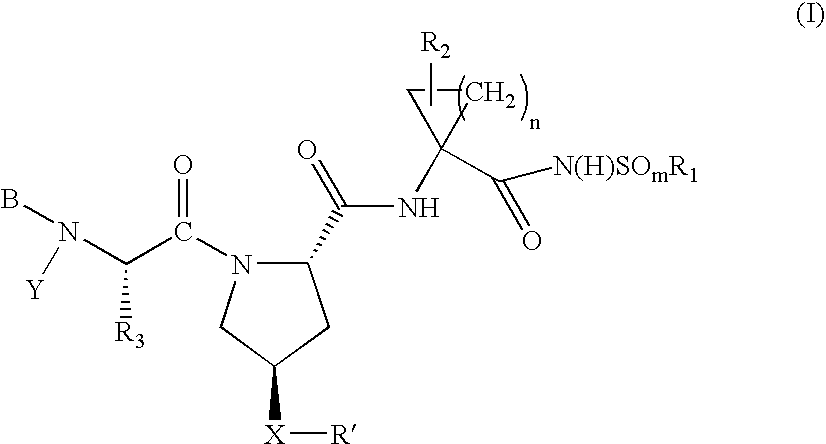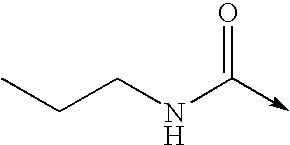Hepatitis C virus inhibitors
a technology of hepatitis c virus and inhibitors, which is applied in the field of antiviral compounds, can solve the problems that a large percentage of patients do not have a sustained reduction in viral load, and achieve the effect of inhibiting the function of ns3 proteas
- Summary
- Abstract
- Description
- Claims
- Application Information
AI Technical Summary
Benefits of technology
Problems solved by technology
Method used
Image
Examples
example 1000
Preparation of Intermediate 1
[0300]
Step 1:
[0301]To a solution of 3-methoxy cinnamic acid (11.04 g, 62 mmol) and triethylamine (12.52 g, 124 mmol) in acetone (80 mL) was added ethyl chloroformate (approximately 1.5 equivalents) dropwise at 0° C. After stirring at this temperature for 1 h, aqueous NaN3 (6.40 g, 100 mmol in 35 mL H2O) was added dropwise and the reaction mixture was stirred for 16 h at the ambient temperature. Water (100 mL) was added to the mixture and the volatile was removed in vacuo. The resulting slurry was extracted with toluene (3×50 mL) and the combined organic layers were dried over MgSO4. This dried solution was added dropwise to a heated solution of diphenylmethane (50 mL) and tributylamine (30 mL) at 190° C. The toluene was distilled off as added. After complete addition, the reaction temperature was raised to 210° C. for 2 h. After cooling, the precipitated product was collected by filtration, washed with hexane (2×50 mL), and dried to yield the desired pro...
example 1001
Preparation of Compound 1001
[0308]
Step 1:
[0309]A slurry of P2 Boc-(4R)-(6-methoxy-isoquinoline-1-oxo)-S-proline]-P1(1R,2S Vinyl Acca)-COOEt (7.88 g, 14.99 mmol) in 4M HCl / dioxane (120 mL, 480 mmol) was stirred for 2 h, removed the solvent in vacuo and azeotroped with dry dioxane. To the residue was added DMF (75 mL), N-methylmorpholine (6.27 mL, 57.07 mmol), Boc-L-tert-leucine (5.20 g, 22.49 mmol), and HATU (8.53 g, 22.49 mmol). The reaction mixture was stirred at rt overnite and worked up by pouring the reaction mixture into ice water and adjusted to pH 5 with aqueous 1.0 N HCl and extracted with EtOAc. The extract was washed with NaHCO3 (aq.), brine, dried (MgSO4) and concentrated. The residue was purified over Biotage 65M column (EtOAc-hexanes: 5-100%) to provide the product (8.07 g, 84%): Retention time: 1.88 method C) MS m / z 639 (M++1).
Step 2:
[0310]To a suspension of the product (4.0 g, 6.26 mmol) of Step 1 of Example 384 {Boc -NH-P3(L-tert-BuGly)-P2[(4R)-(6-methoxyl-isoquinoli...
example 1002
Preparation of Compound 1002
[0313]
[0314]Compound 1002 was prepared in the same procedure as described in Step 3 of Example 1001 in preparation of Compound 1001 instead of 6-Ethoxy-benzothiazole-2-sulfonic acid amide (0.038 g, 0.15 mmol), was used in the place of 4,5-dichloro-thiophene-2-sulfonic acid amide, purified by Prep-HPLC (solvent B: 30% to 100%) to provide the the Compound 1002 (0.0269 mg): 1H NMR (300 MHz, Solvent methanol-d4) δ ppm 1.04 (s, 9H), 1.28 (s, 9H), 1.42 (m, 4H), 1.77 (dd, J=8.05, 5.86 Hz, 1H), 2.20 (m, 1H), 2.30 (m, 1H), 2.62 (dd, J=13.54, 6.95 Hz, 1H), 3.92 (s, 3H), 4.12 (m, 3H), 4.26 (s, 1H), 4.44 (d, J=10.98 Hz, 1H), 4.56 (dd, J=9.33, 7.50 Hz, 1H), 4.79 (d, J=11.34 Hz, 1H), 5.14 (d, J=17.57 Hz, 1H), 5.40 (m, 1H), 5.84 (s, 1H), 7.10 (d, J=9.15 Hz, 1H), 7.23 (m, 3H), 7.60 (d, J=2.20 Hz, 1H), 7.89 (d, J=6.22 Hz, 1H), 7.96 (d, J=8.78 Hz, 1H), 8.10 (d, J=9.15 Hz, 1H); LC-MS (Retention time: 1.97 method A), MS m / z 851 (M++1).
PUM
| Property | Measurement | Unit |
|---|---|---|
| temperature | aaaaa | aaaaa |
| temperature | aaaaa | aaaaa |
| temperature | aaaaa | aaaaa |
Abstract
Description
Claims
Application Information
 Login to View More
Login to View More - R&D
- Intellectual Property
- Life Sciences
- Materials
- Tech Scout
- Unparalleled Data Quality
- Higher Quality Content
- 60% Fewer Hallucinations
Browse by: Latest US Patents, China's latest patents, Technical Efficacy Thesaurus, Application Domain, Technology Topic, Popular Technical Reports.
© 2025 PatSnap. All rights reserved.Legal|Privacy policy|Modern Slavery Act Transparency Statement|Sitemap|About US| Contact US: help@patsnap.com



